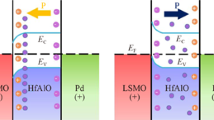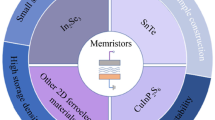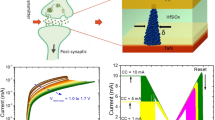Abstract
Memristors are designed to mimic the brain’s integrated functions of storage and computing, thus breaking through the von Neumann framework. However, the formation and breaking of the conductive filament inside a conventional memristor is unstable, which makes it difficult to realistically mimic the function of a biological synapse. This problem has become a main factor that hinders memristor applications. The ferroelectric memristor overcomes the shortcomings of the traditional memristor because its resistance variation depends on the polarization direction of the ferroelectric thin film. In this work, an Au/Hf0.5Zr0.5O2/p+-Si ferroelectric memristor is proposed, which is capable of achieving resistive switching characteristics. In particular, the proposed device realizes the stable characteristics of multilevel storage, which possesses the potential to be applied to multi-level storage. Through polarization, the resistance of the proposed memristor can be gradually modulated by flipping the ferroelectric domains. Additionally, a plurality of resistance states can be obtained in bidirectional continuous reversibility, which is similar to the changes in synaptic weights. Furthermore, the proposed memristor is able to successfully mimic biological synaptic functions such as long-term depression, long-term potentiation, paired-pulse facilitation, and spike-timing-dependent plasticity. Consequently, it constitutes a promising candidate for a breakthrough in the von Neumann framework.
摘要
忆阻器能够模拟人脑兼具存储和计算的功能, 从而突破 冯·诺依曼框架. 然而, 传统忆阻器内部导电细丝的形成和断裂是不 稳定的, 因此难以真实地模仿生物突触的功能, 这个问题已成为阻 碍忆阻器模拟神经突触应用的主要因素. 铁电忆阻器克服了传统 忆阻器的缺点, 因为它的电阻变化取决于铁电薄膜的极化翻转. 本 工作中, 我们提出了一种具有Au/Hf0.5Zr0.5O2/p+-Si结构的铁电忆阻 器, 能够实现电阻开关特性. 重要的是, 该器件能够实现多级存储的 稳定特性, 具有应用于多级存储的潜力. 同时通过调控铁电极化, 忆 阻器的电阻可由铁电畴的翻转来逐步调节. 同时, 我们可以获取具 有双向连续可逆性的多个电阻状态, 这类似于神经突触权重的变 化. 我们还成功模拟了生物学突触功能, 例如长期抑制, 长期促进, 双脉冲易化和尖峰时间依赖可塑性. 因此, 该器件是一种有希望突 破冯·诺依曼框架的候选者.
Similar content being viewed by others
References
Chua L. Memristor-the missing circuit element. IEEE Electr Device L, 1971, 18: 507–519
Strukov DB, Snider GS, Stewart DR, et al. The missing memristor found. Nature, 2008, 453: 80–83
Chanthbouala A, Garcia V, Cherifi RO, et al. A ferroelectric memristor. Nat Mater, 2012, 11: 860–864
Kim DJ, Lu H, Ryu S, et al. Ferroelectric tunnel memristor. Nano Lett, 2012, 12: 5697–5702
Goswami S, Matula AJ, Rath SP, et al. Robust resistive memory devices using solution-processable metal-coordinated azo aromatics. Nat Mater, 2017, 16: 1216–1224
Sangwan VK, Lee HS, Bergeron H, et al. Multi-terminal memtransistors from polycrystalline monolayer molybdenum disulfide. Nature, 2018, 554: 500–504
Yi W, Savel’Ev SE, Medeiros-Ribeiro G, et al. Quantized conductance coincides with state instability and excess noise in tantalum oxide memristors. Nat Commun, 2016, 7: 11142
Yan X, Zhao Q, Chen AP, et al. Vacancy-induced synaptic behavior in 2d WS2 nanosheet-based memristor for low-power neuromorphic computing. Small, 2019, 15: 1901423
Kim KH, Gaba S, Wheeler D, et al. A functional hybrid memristor crossbar-array/CMOS system for data storage and neuromorphic applications. Nano Lett, 2012, 12: 389–395
Soni R, Petraru A, Meuffels P, et al. Giant electrode effect on tunnelling electroresistance in ferroelectric tunnel junctions. Nat Commun, 2014, 5: 5414
Guo R, Wang Y, Yoong HY, et al. Effect of extrinsically introduced passive interface layer on the performance of ferroelectric tunnel junctions. ACS Appl Mater Interfaces, 2017, 9: 5050–5055
Yoong HY, Wu H, Zhao J, et al. Epitaxial ferroelectric Hf0.5Zr0.5O2 thin films and their implementations in memristors for brain-inspired computing Adv Funct Mater, 2018, 28: 1806037
Yoon C, Lee JH, Lee S, et al. Synaptic plasticity selectively activated by polarization-dependent energy-efficient ion migration in an ultrathin ferroelectric tunnel junction Nano Lett, 2017, 17: 1949–1955
Müller J, Böscke TS, Schröder U, et al. Ferroelectricity in simple binary ZrO2 and HfO2. Nano Lett, 2012, 12: 4318–4323
Kim SJ, Mohan J, Summerfelt SR, et al. Ferroelectric Hf0.5Zr0.5O2 thin films: A review of recent advances JOM, 2018, 71: 246–255
Yan X, Zhao J, Liu S, et al. Memristor with Ag-cluster-doped TiO2 films as artificial synapse for neuroinspired computing. Adv Funct Mater, 2018, 28: 1705320
Boyn S, Grollier J, Lecerf G, et al. Learning through ferroelectric domain dynamics in solid-state synapses. Nat Commun, 2017, 8: 14736
Oh S, Kim T, Kwak M, et al. HfZrOx-based ferroelectric synapse device with 32 levels of conductance states for neuromorphic applications. IEEE Electron Device Lett, 2017, 38: 732–735
Yan X, Pei Y, Chen H, et al. Self-assembled networked PbS distribution quantum dots for resistive switching and artificial synapse performance boost of memristors. Adv Mater, 2019, 31: 1805284
Yin YW, Burton JD, Kim YM, et al. Enhanced tunnelling electroresistance effect due to a ferroelectrically induced phase transition at a magnetic complex oxide interface. Nat Mater, 2013, 12: 397–402
Chanthbouala A, Crassous A, Garcia V, et al. Solid-state memories based on ferroelectric tunnel junctions. Nat Nanotech, 2011, 7: 101–104
Wen Z, Li C, Wu D, et al. Ferroelectric-field-effect-enhanced electroresistance in metal/ferroelectric/semiconductor tunnel junctions. Nat Mater, 2013, 12: 617–621
Luo ZD, Peters JJP, Sanchez AM, et al. Flexible memristors based on single-crystalline ferroelectric tunnel junctions. ACS Appl Mater Interfaces, 2019, 11: 23313–23319
Wang ZJ, Bai Y Resistive switching behavior in ferroelectric heterostructures. Small, 2019, 15: 1805088
Yan X, Zhou Z, Ding B, et al. Superior resistive switching memory and biological synapse properties based on a simple TiN/SiO2/p-Si tunneling junction structure. J Mater Chem C, 2017, 5: 2259–2267
Ambriz-Vargas F, Kolhatkar G, Broyer M, et al. A complementary metal oxide semiconductor process-compatible ferroelectric tunnel junction. ACS Appl Mater Interfaces, 2017, 9: 13262–13268
Pantel D, Alexe M. Electroresistance effects in ferroelectric tunnel barriers. Phys Rev B, 2010, 82: 134105
Pantel D, Goetze S, Hesse D, et al. Room-temperature ferroelectric resistive switching in ultrathin Pb(Zr0.2Ti0.8)O3 films. ACS Nano, 2011, 5: 6032–6038
Matveyev Y, Egorov K, Markeev A, et al. Resistive switching and synaptic properties of fully atomic layer deposition grown TiN/HfO2/TiN devices. J Appl Phys, 2015, 117: 044901
Hoffmann M, Schroeder U, Schenk T, et al. Stabilizing the ferroelectric phase in doped hafnium oxide. J Appl Phys, 2015, 118: 072006
Li C, Hu M, Li Y, et al. Analogue signal and image processing with large memristor crossbars. Nat Electron, 2017, 1: 52–59
Shosuke F, Yuuichi K, Tsunehiro I, et al. First demonstration and performance improvement of ferroelectric HfO2-based resistive switch with low operation current and intrinsic diode property. In: Proceedings of the IEEE Symposium on VLSI Technology. Honolulu, 2016
Sang X, Grimley ED, Schenk T, et al. On the structural origins of ferroelectricity in HfO2 thin films. Appl Phys Lett, 2015, 106: 162905
Covi E, Brivio S, Fanciulli M, et al. Synaptic potentiation and depression in Al:HfO2-based memristor. MicroElectron Eng, 2015, 147: 41–44
Guo R, Zhou Y, Wu L, et al. Control of synaptic plasticity learning of ferroelectric tunnel memristor by nanoscale interface engineering. ACS Appl Mater Interfaces, 2018, 10: 12862–12869
Yang R, Huang HM, Hong QH, et al. Synaptic suppression triplet-STDP learning rule realized in second-order memristors. Adv Funct Mater, 2018, 28: 1704455
Park MH, Kim HJ, Kim YJ, et al. Study on the degradation mechanism of the ferroelectric properties of thin Hf0.5Zr0.5O2 films on TiN and Ir electrodes. Appl Phys Lett, 2014, 105: 072902
Jin Hu W, Wang Z, Yu W, et al. Optically controlled electro-resistance and electrically controlled photovoltage in ferroelectric tunnel junctions. Nat Commun, 2016, 7: 10808
Garcia V, Bibes M. Ferroelectric tunnel junctions for information storage and processing. Nat Commun, 2014, 5: 4289
Li C, Huang L, Li T, et al. Ultrathin BaTiO3-based ferroelectric tunnel junctions through interface engineering. Nano Lett, 2015, 15: 2568–2573
Fan Z, Xiao J, Wang J, et al. Ferroelectricity and ferroelectric resistive switching in sputtered Hf0.5Zr0.5O2 thin films. Appl Phys Lett, 2016, 108: 232905
Kozodaev MG, Chernikova AG, Korostylev EV, et al. Ferroelectric properties of lightly doped La:HfO2 thin films grown by plasmaassisted atomic layer deposition. Appl Phys Lett, 2017, 111: 132903
Milano G, Luebben M, Ma Z, et al. Self-limited single nanowire systems combining all-in-one memristive and neuromorphic functionalities. Nat Commun, 2018, 9: 5151
Yoon JH, Wang Z, Kim KM, et al. An artificial nociceptor based on a diffusive memristor. Nat Commun, 2018, 9: 417
E. Covi SB, A. Serb, T. Prodromakis, et al. HfO2-based memristors for neuromorphic applications. In: Proceedings of the IEEE International Symposium on Circuits and Systems (ISCAS). Montreal, 2016. 393–396
Mikheev V, Chouprik A, Lebedinskii Y, et al. Ferroelectric second-order memristor. ACS Appl Mater Interfaces, 2019, 11: 32108–32114
Yan X, Wang K, Zhao J, et al. A new memristor with 2D Ti3C2Tx MXene flakes as an artificial bio-synapse. Small, 2019, 15: 1900107
Wang G, Yan X, Chen J, et al. Memristors based on the hybrid structure of oxide and boron nitride nanosheets combining memristive and neuromorphic functionalities. Phys Status Solidi RRL, 2019, 14: 1900539
Yan X, Zhang L, Chen H, et al. Graphene oxide quantum dots based memristors with progressive conduction tuning for artificial synaptic learning. Adv Funct Mater, 2018, 28: 1803728
Zarubin S, Suvorova E, Spiridonov M, et al. Fully ALD-grown TiN/Hf0.5Zr0.5O2/TiN stacks: Ferroelectric and structural properties. Appl Phys Lett, 2016, 109: 192903
Acknowledgements
This work was supported by the National Natural Science Foundation of China (61674050 and 61874158), the Outstanding Youth Project of Hebei Province (F2016201220), the Outstanding Youth Cultivation Project of Hebei University (2015JQY01), the Project of Science and Technology Activities for Overseas Researcher (CL 201602), the Project of Distinguished Young of Hebei Province (A2018201231), the Support Program for the Top Young Talents of Hebei Province (70280011807), the Training and Introduction of High-level Innovative Talents of Hebei University (801260201300), the Hundred Persons Plan of Hebei Province (E2018050004 and E2018050003), and the Supporting Plan for 100 Excellent Innovative Talents in Colleges and Universities of Hebei Province (SLRC2019018)
Author information
Authors and Affiliations
Contributions
Yan X conceived the idea and revised the paper. Yu T fabricated the samples, finished the test data and prepared the manuscript. Chang J and Chen J coordinated this study. This article was discussed with contributions from all authors. All authors have approved the final version of this article.
Corresponding authors
Additional information
Conflict of interest
The authors declare that they have no conflict of interest.
Supplementary information
Experimental details are available in the online version of the paper.
Xiaobing Yan is currently a professor at the College of Electronic Information Engineering, Hebei University. He received his PhD degree from Nanjing University in 2011. From 2014 to 2016, he held the Research Fellow position at the National University of Singapore. His current research interest is in the field of memristors.
Tianqi Yu received a bachelor’s degree from Henan University of Science and Technology in 2018. He is a graduate student at the College of Electronic Information Engineering, Hebei University. His current research focuses on ferroelectric materials for memristor applications.
Electronic Supplementary Material
40843_2020_1444_MOESM1_ESM.pdf
Ferroelectric memristor based on Hf0.5Zr0.5O2 has potential of multi-level storage and characteristic of artificial synaptic plasticity
Rights and permissions
About this article
Cite this article
Yu, T., He, F., Zhao, J. et al. Hf0.5Zr0.5O2-based ferroelectric memristor with multilevel storage potential and artificial synaptic plasticity. Sci. China Mater. 64, 727–738 (2021). https://doi.org/10.1007/s40843-020-1444-1
Received:
Accepted:
Published:
Issue Date:
DOI: https://doi.org/10.1007/s40843-020-1444-1




